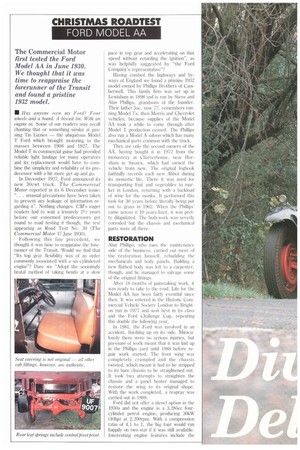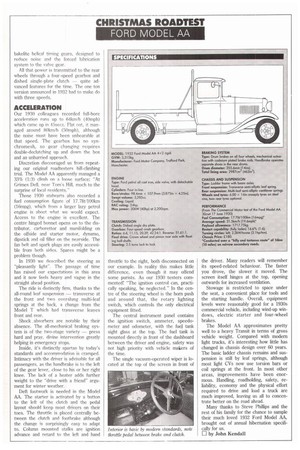CHRISTMAS ROADTEST FORD VODEL AA
Page 20

Page 22

If you've noticed an error in this article please click here to report it so we can fix it.
The Commercial Motor first tested the Ford Model AA in June 1930. We thought that it was time to reappraise the forerunner of the Transit and found a pristine 1932 model.
• has anyone seen my Ford? Four wheels and a board. A biscuit tin. With an engine in. Some of our readers may recall chanting that or something similar at passing Tin Lizzies — the ubiquitous Model I Ford which brought motoring to the masses between 1908 and 1927. The Model T in commercial guise had provided reliable light haulage for many operators and its replacement would have to combine the simplicity and reliability of its predecessor with a bit more get up and go.
In December 1927, Ford announced its new 30cwt truck. The Commercial Motor reported in its 6 December issue: ". . . unusual precautions have been taken to prevent any leakage of information regarding it". Nothing changes. CM's eager readers had to wait a leisurely 21/2 years before our esteemed predecessors got round to road testing it though, the test appearing as Road Test No. 30 (The Commercial Motor 17 June 1930).
Following this fine precedent, we thought it was time to reappraise the forerunner of the Transit. Would we find that "Its top gear flexibility was of an order commonly associated with a six-cylindered engine"? Dare we "Adopt the seemingly brutal method of taking bends at a slow
pace in top gear and accelerating on that speed without retarding the ignition", as was helpfully suggested by "the Ford Company's representative"?
Having combed the highways and byways of England we found a pristine 1932 model owned by Phillips Brothers of Camberwell. This family firm was set up in Lewisham in 1898 and is am by Steve and Alan Phillips. grandsons of the founder. Their father Joe, now 77, remembers running Model Ts, then Morris and Chevrolet vehicles, because supplies of the Model AA took a while to come through after Model 'I' production ceased. 'Hie Phillips also run a Model A saloon which has many mechanical parts common with the truck.
They are only the second owners of the AA, having bought it in 1972 from the monastery at Charterhouse. near Horsham in Sussex, which had owned the vehicle from new. The original logbook faithfully records each new Abbot during its monastic life. There it was used for transporting fruit and vegetables to market in London, returning with a backload of wine for the monks. It performed this task for 30 years before literally being put out to grass in 1962. When the Phillips' came across it 10 years later, it was pretty dilapidated. The bodywork was ses;erly corroded but the chassis and mechanical parts were all there.
RESTORATION
Alan Phillips, who runs the maintenance side of the business, carried out most of the restoration himself, rebuilding the mechanicals and body panels. Building a new flatbed body was left to a carpenter, though, and he managed to salvage some of the original fittings.
After 18 months of painstaking work, it was ready to take to the road. Life for the Model AA has been fairly eventful since then. It was entered in the Historic Commercial Vehicle Society London to Brighton run in 1977 and won best in its class and the Ford Challenge Cup, repeating this double the following year.
In 1981, the Ford was involved in an accident, finishing U on its side. Miraculously there were no serious injuries, but pressure of work meant that it was laid up in the Phillips yard until 1988 before repair work started. The front wing was completely crumpled and the chassis twisted, which meant it had to he stripped to its bare chassis to be straightened out. It took two attempts to straighten the chassis and a panel beater managed to restore the wing to its original shape. With the work completed, a respray was carried out in 1989.
Ford did not offer a diesel option in the 1930s and the engine is a 3,285cc fourcylinder petrol engine, producing 30kW (40hp) at 2,200rpm. With a compression ratio of 4.1 to 1, the big four would run happily on two-star if it was still available. Interesting engine features include the
bakelite helical timing gears, designed to reduce noise and the forced lubrication system to the valve gear.
All that power is transmitted to the rear wheels through a four-speed gearbox and dished single-plate clutch — quite advanced features for the time. The one ton version announced in 1932 had to make do with three speeds.
ACCELERATION
Our 1930 colleagues recorded full-bore acceleration runs up to 64krn/h (40mph) which came up in 45secs. Flat out, it managed around 801on/h (50mph), although the noise must have been unbearable at that speed. The gearbox has no synchromesh, so gear changing requires double-declutching up and down the box and an unhurried approach.
Discretion discouraged us from repeating our original roadtesters hill-climbing trial. The Model AA apparently managed a 33% (1:3) climb on a loose surface: "At Grimes Dell. near Tom's Hill. much to the surprise of local residents."
Those 1930 stalwarts also recorded a fuel consumption figure of 17.71it/1001un (16mog), which from a larger lazy petrol engine is about what we would expect. Access to the engine is excellent. The centre hinged bonnet opens on to the distributor, carburettor and manifolding on the offside and starter motor, dynamo, dipstick and oil filler on the nearside. The fan belt and spark plugs are easily accessible from both sides. Spares might be a problem though.
In 1930 we described the steering as "pleasantly light". The passage of time has raised our expectations in this area and it now feels heavy and vague in the straight ahead position.
The ride is distinctly firm, thanks to the all-rnund leaf suspension — transverse at the front and two overslung multi-leaf springs at the back, a change from the Model T which had transverse leayes front and rear.
Shock . absorbers are notable by their absence. The all-mechanical braking system is of the two-stage variety — press hard and pray, divine intervention greatly helping in emergency stops.
Inside, it's distinctly spartan by today's standards and accommodation is cramped. Intimacy with the driver is advisable for all passengers. as the handbrake is to the left of the gear lever, close to his or her right knee. The lack of a heater adds further weight to the "drive with a friend" argument for winter weather.
Deft footwork is needed in the Model AA. The starter is activated by a button to the left of the clutch and the pedal layout should keep most drivers on their toes. The throttle is placed centrally between the clutch and foothrake although the change is surprisingly easy to adapt to. Column mounted stalks are ignition advance and retard to the left and hand throttle to the right, both disconnected on our example. In reality this makes little difference, even though it may offend some purists. As our 1930 testers commented! "The ignition control can, practically speaking, be neglected." In the centre of the steering wheel is the horn push and around that, the rotary lighting switch, which controls the only electrical equipment fitted.
The central instrument panel contains the ignition switch, ammeter, speedometer and odometer, with the fuel tank sight glass at the top. The fuel tank is mounted directly in front of the dashboard between the driver and engine, safety was not high priority with vehicle makers of the time.
The single vacuum-operated wiper is located at the top of the screen in front of the driver. Many readers will remember its speed-related behaviour. The faster you drove, the slower it moved. The screen itself hinges at the top, opening outwards for increased ventilation.
Stowage is restricted to space under the seat, a convenient place for tools and the starting handle. Overall, equipment levels were reasonably good for a 1930s commercial vehicle, including wind-up windows, electric starter and four-wheel brakes.
The Model AA approximates pretty well to a heavy Transit in terms of gross vehicle weight. Compared with modern light trucks, it's interesting how little has changed in chassis design over 60 years. The basic ladder chassis remains and suspension is still by leaf springs, although most light CVs now use torsion bars or coil springs at the front. In most other areas, improvements have been enormous. Handling, roadholding, safety, reliability, economy and the physical effort required to drive and load a truck are much improved, leaving us all to concentrate better on the road ahead.
Many thanks to Steve Phillips and the rest of his family for the chance to sample their much loved 1932 Ford Model AA, brought out of annual hibernation specifically for us.
0 by John Kendall
























































